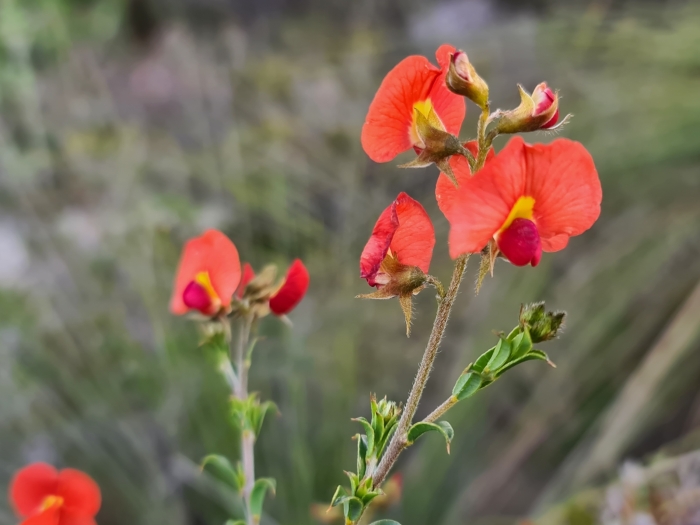Yellow-Eyed Flame Pea
(Chorizema dicksonii)
Yellow-Eyed Flame Pea (Chorizema dicksonii)
/
/

Cal Wood
CC BY 4.0
Image By:
Cal Wood
Recorded By:
Copyright:
CC BY 4.0
Copyright Notice:
Photo by: Cal Wood | License Type: CC BY 4.0 | License URL: http://creativecommons.org/licenses/by/4.0/ | Rights Holder: Cal Wood | Publisher: iNaturalist | Date Created: 2020-08-23T17:23:38-07:00 |



























Estimated Native Range
Summary
Chorizema dicksonii, commonly known as Yellow-Eyed Flame Pea, is an evergreen subshrub native to the gravelly soils of open forests and shrublands in Southwest Australia. It typically grows to a height and width of 1-3 feet (0.3-0.9 meters), forming a compact, rounded shape. The plant is notable for its striking pea-like flowers, which are a vibrant combination of yellow and red, blooming profusely from late winter to early summer. The flowers are particularly showy, making it a desirable species for ornamental use.
Yellow-Eyed Flame Pea is valued for its long flowering season and its ability to attract pollinators such as bees. It is used in cultivation for rockeries, native plant gardens, and as a container plant due to its moderate size and vibrant flowers. This subshrub prefers well-drained, sandy or loamy soils, and while it tolerates dry conditions once established, it benefits from regular watering during extended dry periods. It thrives in full sun but can tolerate light shade. In areas with heavy or clay soils, raised beds or containers can provide the necessary drainage. There are no widely recognized cultivars, but the species itself is a standout. Potential problems include root rot if overwatered or planted in poorly draining soils. It is not known to be invasive when grown outside its native range.CC BY-SA 4.0
Yellow-Eyed Flame Pea is valued for its long flowering season and its ability to attract pollinators such as bees. It is used in cultivation for rockeries, native plant gardens, and as a container plant due to its moderate size and vibrant flowers. This subshrub prefers well-drained, sandy or loamy soils, and while it tolerates dry conditions once established, it benefits from regular watering during extended dry periods. It thrives in full sun but can tolerate light shade. In areas with heavy or clay soils, raised beds or containers can provide the necessary drainage. There are no widely recognized cultivars, but the species itself is a standout. Potential problems include root rot if overwatered or planted in poorly draining soils. It is not known to be invasive when grown outside its native range.CC BY-SA 4.0
Plant Description
- Plant Type: Subshrub
- Height: 1-3 feet
- Width: 1-3 feet
- Growth Rate: Moderate
- Flower Color: Yellow, Red
- Flowering Season: Summer, Fall, Winter
- Leaf Retention: Evergreen
Growth Requirements
- Sun: Full Sun
- Water: Medium
- Drainage: Medium
Common Uses
Border Plant, Low Maintenance, Potted Plant, Rock Garden
Natural Habitat
Open forests and shrublands in Southwest Australia
Other Names
Common Names: Flame Pea
Scientific Names: , Chorizema dicksonii, Chorizema costatum var. lanceolatum, Chorizema costatum, Chorizema costatum var. brevifolium, Chorizema costatum var. lineare,
GBIF Accepted Name: Chorizema dicksonii Graham